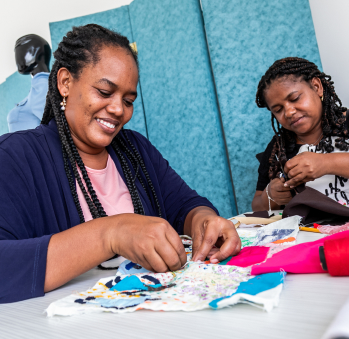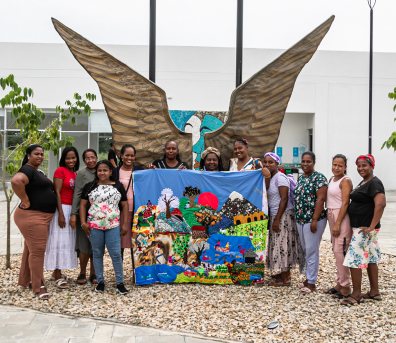Tejedoras de Mampuján
Workshop: Museo de Arte y Memoria de Mampuján
Craft: Trabajo en tela
Trail: Bolívar Route
Location: María La Baja, Bolívar
In 2005, fifteen women gathered for the first time around a piece of fabric, seeking to ease the pain left by the war, break the echoes of violence that still reverberated in their homes, transcend the desire for revenge, and build a culture of peace. They were from Mampuján, part of the 245 families who had been forcibly displaced and who had suffered the massacre of thirteen farmers in the Las Brisas area at the hands of the AUC on March 11, 2000. Alongside the psychologist and artist Teresa Geisser, they learned to sew their story, stitching one piece of cloth over another to portray what had happened to them—a task that fit well with the knowledge of the women from Mampuján, who were accustomed to making clothes and crafting rag dolls. Today, they are known as the Weavers of Mampuján, a group of about one hundred women who were honored with the National Peace Award in 2015, the Colombian-Swiss “Creativity in the Life of Rural Women” award in 2014, and the Carlos Mauro Hoyos Award from the Attorney General’s Office in 2018. Their tapestries, which have traveled to the United States, Peru, Nicaragua, El Salvador, Canada, Ireland, Switzerland, and South Africa, are an example of how pain can be transformed into beauty.
Joining scraps to tell their own stories and seeing them represented from an external perspective, in the third person, is an exercise that heals when words fail. Each woman, with her own senses, began placing one color next to another, sharing what had happened to her in a communal space where, stitch by stitch, her wounds began to heal. The conflict is not only represented by a man armed with a rifle, it is also what happened to them as girls, the way war passed through the bodies. It is the domestic violence that follows, the lack of economic independence for mothers, and the arrival of Afro-descendants as slaves to the Americas. Drawing all those stories in a tapestry became a way to build a collective memory—so that others could know what happened, how it happened, and to ensure that it never happens again.
We can recount our own traumas and transform them into phrases that no longer live inside us, into a poem, a drawing, or a tapestry. This is something that Juana Alicia Ruíz knows very well. She seems to have been born with an innate instinct for healing through art. She is the director of the Mampuján Museum of Art and Memory and the coordinator of the Mampuján Women’s Association Weaving Dreams and Flavors. From a young age, she discovered that singing and drawing could ward off demons—they distracted her from the persistent memories of sexual abuse and transported her to other places, to the paths and waterfalls she herself drew, to the giant tree she could climb to pick fruit.
In addition to understanding the healing power of weaving, singing, and drawing, Juana Alicia emphasizes the infinite power of sitting down at the table in community. It is a space for conversation and peaceful conflict resolution. It is where a child should feel safe to tell their parents and siblings about any problems they are having at school and to receive guidance. It is where we feel loved when we are given food. For Juana Alicia, this brings to mind memories of her family sitting on the floor around the cauldron, with her mother handing out pieces of food—meat, yucca, and rice—placed on banana leaves to eat with soup in totuma bowls. It was there that they vented, shared how their day had gone, and the invisible threads that bind a family were woven. As an adult, she also learned about the chemical effects of tasty food—the feel-good hormones released when we taste something delicious, perhaps a recipe that takes us back to childhood and reminds us of unity and warmth. That’s why she places special emphasis on including Mampuján’s cuisine in the realm of memory and collective healing. Because the hands that weave also cook, and relief is found in the details. Like when they called the children of the shelters they arrived at as displaced persons—children who didn’t like the taste of welfare flour—and taught them how to cook it to make dulce de leche, and how to pick fruits from the yard to make jam. They gave them a space to transform bitterness into sweetness.
The Mampuján Museum of Art and Memory is the result of the Justice and Peace law judgment from December 13, 2012, the outcome of the community’s struggle for reparations and to dignify their memory. It is a refuge where “experiences that can be touched, seen, tasted, smelled, heard, and woven are exchanged.” It is the perfect place to understand the universe of its people and their land, from the old Mampuján to the displacement, and the rebirth of New Mampuján.
Craft





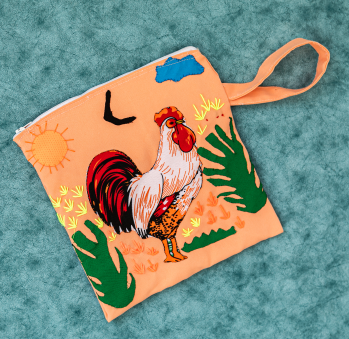

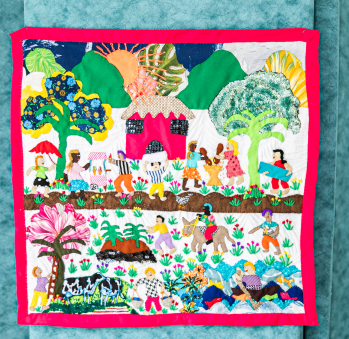
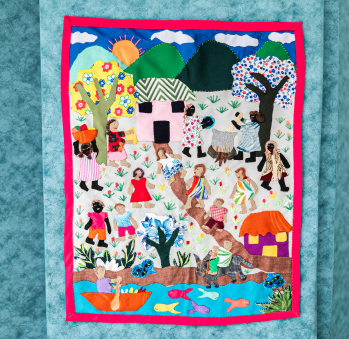









Artisans along the way
Artisans along the way
No puede copiar contenido de esta página










































